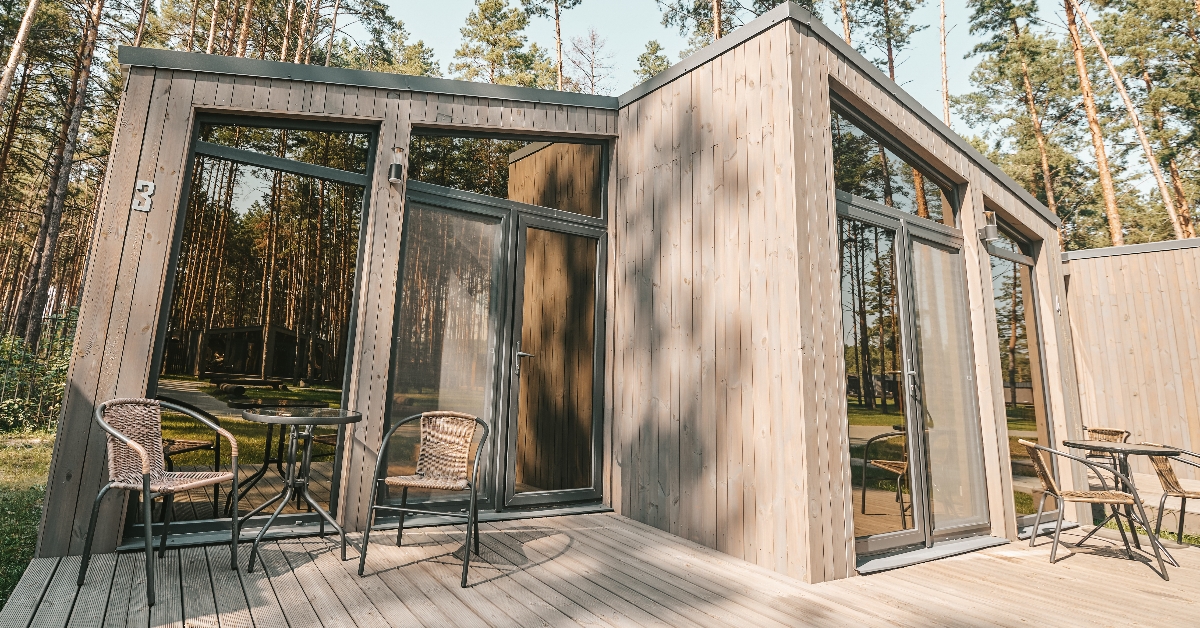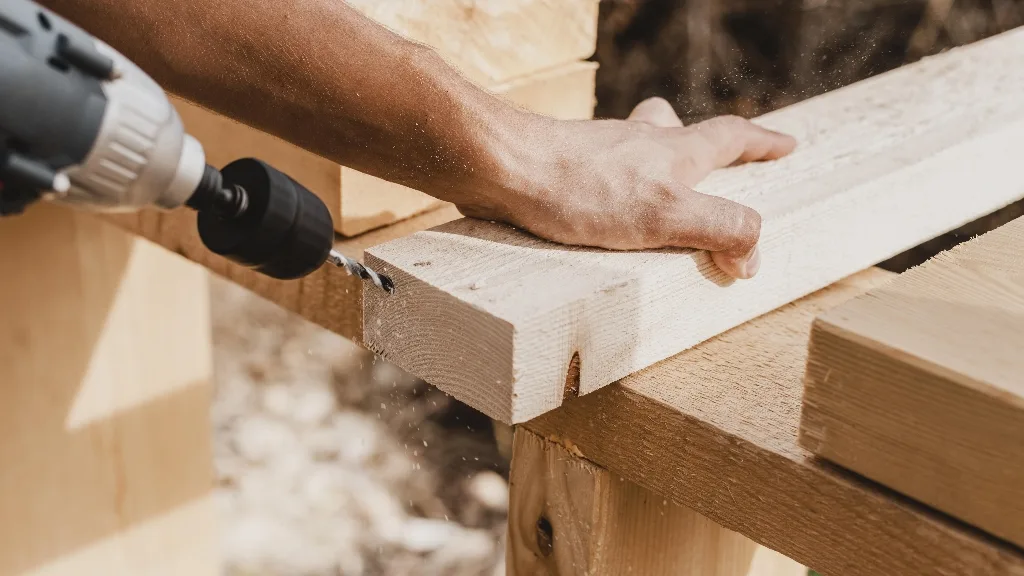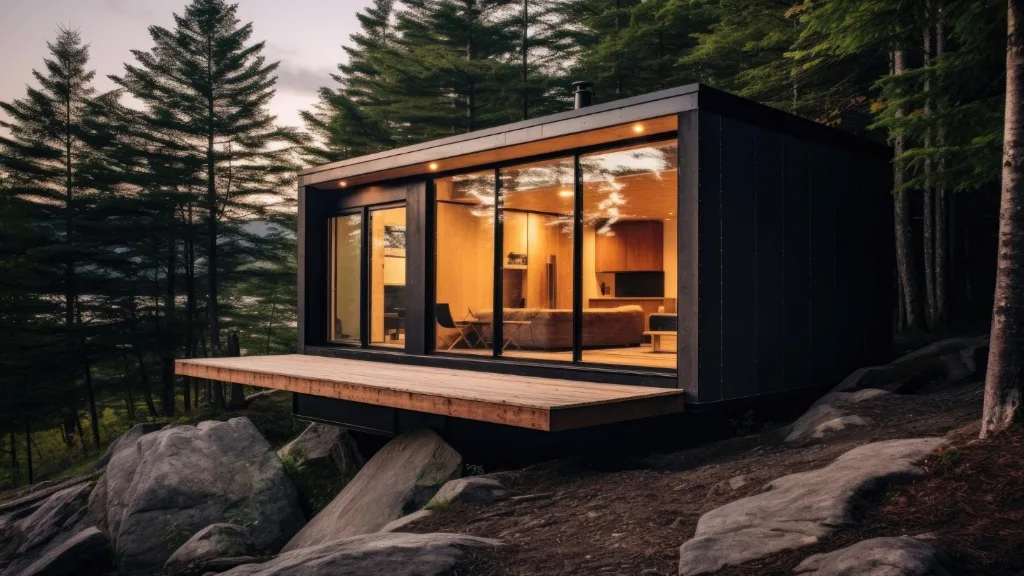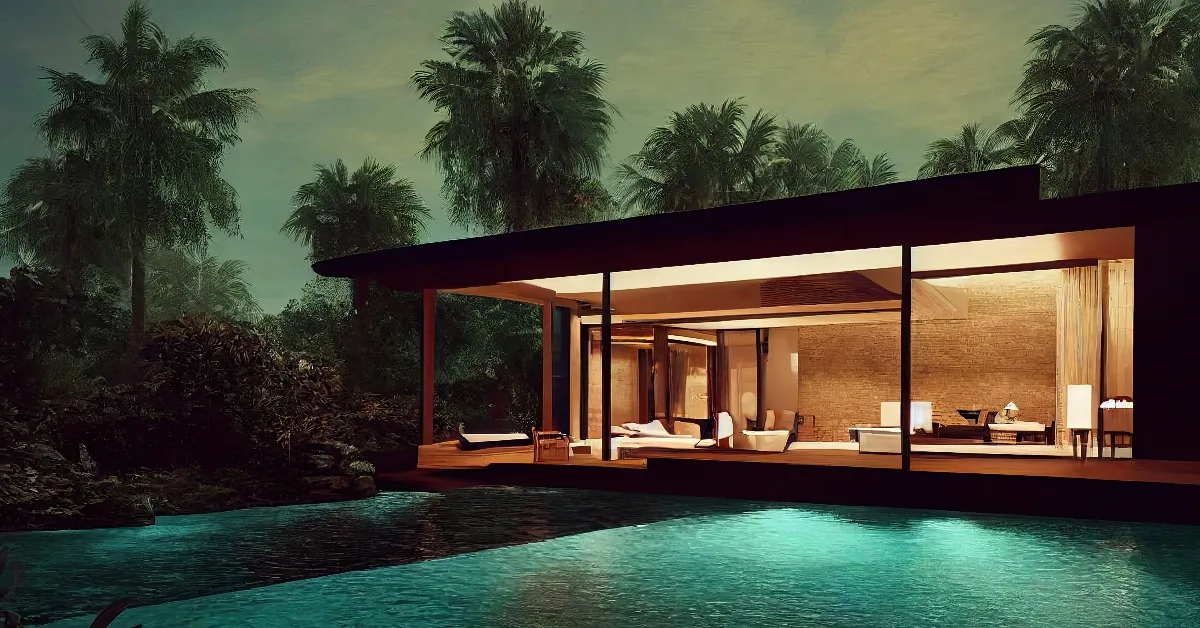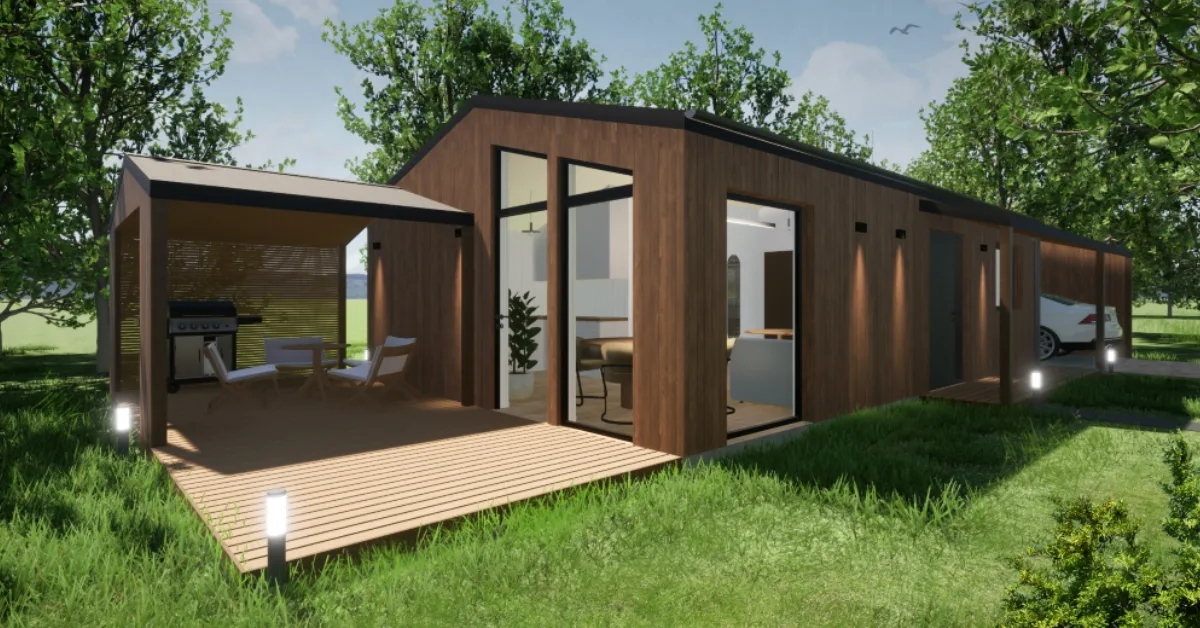Wooden houses have always been an integral part of architectural history, offering both aesthetic and functional value. This piece seeks to answer ten of the most frequently asked questions regarding wooden houses, shedding light on their benefits, construction processes, and modern innovations such as WXP panels. Through this exploration, we aim to provide a comprehensive understanding of the enduring appeal and contemporary relevance of wooden houses.
What are the Benefits of Living in a Wooden House?
Wooden houses offer a myriad of benefits that contribute to a wholesome living experience. They are known for their timeless aesthetic, eco-friendliness, and the warm, comforting ambiance they provide.
- Eco-Friendliness: Wood is a natural, renewable resource. When harvested sustainably, it serves as an eco-friendly material choice for construction. Moreover, the carbon footprint of a wooden house is significantly lower compared to houses made from steel or concrete.
- Energy Efficiency: Wood has natural insulation properties which can help in reducing energy costs. During winters, wooden houses retain heat, and in summers, they stay cool, thus minimizing the reliance on artificial heating and cooling systems.
- Aesthetic Appeal: The natural beauty of wood with its unique grains and tones adds a rustic charm and elegance to the home. This timeless aesthetic appeal makes wooden houses a popular choice among homeowners.
- Health Benefits: Wood has been found to have several health benefits. It creates a natural and healthy living environment, with better air quality. The organic nature of wood can also have a calming and stress-reducing effect on the occupants.
- Durability and Strength: With proper care and maintenance, wooden houses can last for generations. Modern treatment methods have made wood resistant to pests, rot, and fire, enhancing its durability.
- Ease of Construction: Wooden houses are relatively easier and quicker to build as compared to brick or concrete houses. The construction process is less labor-intensive and can be completed with fewer resources.
- Flexibility in Design: Wood is a versatile material that allows for a wide range of architectural styles and designs. Its flexibility enables architects to create unique and personalized designs for homeowners.
- Cost-Effectiveness: Initially, the cost of building a wooden house might be high, but in the long run, the energy savings, low maintenance costs, and longevity make it a cost-effective housing option.
- Acoustic Properties: Wood has good sound-absorbing properties which contribute to a quieter and peaceful living environment.
- Thermal Comfort: The thermal mass of wood contributes to a comfortable living environment by maintaining a balanced indoor temperature.
Incorporating modern innovations like WXP panels can further enhance the structural integrity, insulation, and design possibilities of wooden houses, making them a viable and attractive option in the contemporary housing market.
How are Wooden Houses Constructed?
The construction process of wooden houses involves a series of well-coordinated steps, ensuring that the structure is solid, safe, and aesthetically appealing. Below is an outline of the typical construction process:
- Site Preparation:
- This initial step involves clearing the land, leveling the ground, and laying a strong foundation, which is crucial for the stability of the house.
- Design and Planning:
- Architectural designs are created according to the homeowner’s preferences and local building codes. This phase also includes planning the electrical, plumbing, and heating systems.
- Material Preparation:
- High-quality timber is selected and treated to ensure durability and resistance to pests and rot. Other materials like glass, steel, or stone may also be prepared depending on the design.
- Frame Construction or Panel Installation:
- Traditional wooden houses are often built using a frame construction method where a skeleton frame is erected first. However, modern methods may employ the use of solid construction panels that can be installed directly, which can expedite the construction process.
- Roof and Floor Installation:
- The roof and floors are installed. Materials and construction methods may vary based on design preferences and local climate conditions.
- Wall Construction:
- Walls are constructed, ensuring they are properly insulated and sealed to protect against external elements.
- Insulation:
- Additional insulation may be added to enhance energy efficiency and comfort within the house.
- Interior and Exterior Finishing:
- Interior finishing includes installing cabinetry, flooring, and painting, while exterior finishing involves painting, siding, and installing doors and windows.
- Inspection and Handover:
- The construction is inspected to ensure compliance with building codes, and upon approval, the house is handed over to the owners.
The process of constructing a wooden house can vary significantly based on the design, location, and the construction methods employed. Modern advancements, such as the use of pre-fabricated panels, have introduced efficient alternatives to traditional construction methods, providing homeowners with more options to meet their specific needs and preferences.
What Maintenance is Required for Wooden Houses?
Maintaining a wooden house to ensure its longevity and aesthetic appeal is a task that requires a systematic approach. Here’s an in-depth look into the maintenance steps and considerations:
- Regular Inspection:
- Conducting regular inspections to check for signs of damage, rot, or pest infestations is crucial. Early detection allows for timely repairs, preventing minor issues from escalating.
- Cleaning:
- A thorough cleaning of the exterior and interior wood surfaces should be done periodically. This helps in removing dirt, mildew, and algae which can cause the wood to deteriorate.
- Painting and Staining:
- Applying a fresh coat of paint or stain can protect the wood from the elements, while also refreshing the appearance of the house.
- Sealing:
- Wood sealants provide a protective layer against moisture, which is essential to prevent rot and mold growth.
- Pest Control:
- Implementing pest control measures to prevent or treat infestations from wood-boring insects like termites is crucial for maintaining the structural integrity of the house.
- Repairing Damages:
- Any damages such as cracks, holes, or loose boards should be repaired promptly. This might involve filling cracks, replacing damaged wood, or tightening loose fixtures.
- Gutter Maintenance:
- Keeping gutters clean and ensuring proper drainage prevents water from pooling and causing damage to the wood.
- Ventilation:
- Ensuring proper ventilation prevents excessive moisture buildup which can lead to mold and mildew.
- Upgrading Insulation:
- Over time, upgrading insulation with modern materials like WXP panels can enhance the energy efficiency and comfort of the wooden house.
- Consulting Professionals:
- Engaging professionals for regular maintenance checks and advice can be a wise investment to ensure the long-term health of the wooden house.
Maintenance is a continuous process that requires a proactive approach. Through diligent care and attention to the above-mentioned aspects, homeowners can ensure that their wooden houses remain beautiful, sturdy, and comfortable for many years to come.
How Do Modern Technologies Like WXP Panels Enhance Wooden House Construction?
Modern technologies have ushered in innovative solutions that significantly enhance the construction and performance of wooden houses. One such innovation is the WXP panel, a modern construction material that brings multiple benefits to wooden house construction:
- Improved Insulation:
- WXP panels are known for their superior insulation properties. They help in maintaining a comfortable indoor temperature regardless of external weather conditions, leading to lower heating and cooling costs.
- Enhanced Structural Integrity:
- These panels add to the structural strength of wooden houses, making them more robust and durable against external pressures and impacts.
- Quick and Easy Installation:
- The design of WXP panels allows for quick and easy installation, reducing the construction time and labor costs associated with traditional building methods.
- High-Quality Material:
- Made from high-quality materials, WXP panels are resistant to warping, cracking, and other common issues associated with wood, ensuring a longer lifespan for the house.
- Aesthetic Appeal:
- WXP panels offer a sleek, modern aesthetic without compromising the natural charm and warmth of wooden houses.
- Environmentally Friendly:
- The panels are eco-friendly and contribute towards the sustainability of wooden house construction by minimizing waste and utilizing recyclable materials.
- Sound Insulation:
- Besides thermal insulation, WXP panels also provide excellent sound insulation, contributing to a peaceful and quiet indoor environment.
- Cost-Effectiveness:
- While the initial investment may be higher, the long-term benefits in terms of reduced maintenance, energy savings, and durability make WXP panels a cost-effective choice.
- Customization:
- WXP panels can be customized to meet specific design requirements, allowing for a wide range of architectural styles and finishes.
- Fire Resistance:
- The panels come with enhanced fire-resistant properties, providing an added level of safety to wooden house constructions.
The integration of modern technologies like WXP panels is a testament to the evolving nature of wooden house construction. By embracing such innovations, homeowners and builders can address common challenges associated with wooden houses, making them more appealing and suitable for contemporary living needs.
How Do Wooden Houses Compare to Other Types of Houses?
When considering a home, comparing wooden houses to other types of houses such as brick, concrete, or steel constructions is important to make an informed decision. Here’s a comparative analysis based on various factors:
- Cost:
- Wooden Houses: Initially, the cost may be higher due to the price of quality timber, but long-term maintenance and energy costs could be lower.
- Other Types: Concrete and brick houses may have a lower initial cost but can incur higher long-term maintenance costs.
- Construction Time:
- Wooden Houses: Generally quicker to construct due to the prefabricated materials like WXP panels, and simpler construction techniques.
- Other Types: Construction time can be longer due to the curing and drying times of materials like concrete.
- Durability:
- Wooden Houses: With modern treatment methods, wood can be made resistant to pests, rot, and fire, resulting in a long-lasting structure.
- Other Types: Concrete and steel are inherently durable and resistant to many common hazards.
- Insulation:
- Wooden Houses: Natural insulation properties of wood contribute to energy efficiency.
- Other Types: May require additional insulation to achieve similar levels of energy efficiency.
- Aesthetic Appeal:
- Wooden Houses: Offer a unique, warm, and natural aesthetic.
- Other Types: May lack the organic appeal of wood, but can also be designed to be visually pleasing.
- Environmental Impact:
- Wooden Houses: Eco-friendlier if sourced from sustainable forests and recyclable.
- Other Types: Production of materials like concrete and steel has a higher carbon footprint.
- Maintenance:
- Wooden Houses: Require regular maintenance to protect against pests and weather elements.
- Other Types: May require less maintenance over time.
- Flexibility in Design:
- Wooden Houses: Wood is a versatile material allowing for a wide range of architectural styles.
- Other Types: May not offer as much flexibility in design and alterations.
- Sound Insulation:
- Wooden Houses: Natural sound insulation properties contribute to a quieter living environment.
- Other Types: May require additional soundproofing measures.
- Thermal Comfort:
- Wooden Houses: Wood’s thermal mass contributes to a balanced indoor temperature.
- Other Types: May require more heating and cooling to maintain comfortable temperatures.
Each type of house has its merits and demerits. The choice largely depends on personal preferences, budget, and the climate of the region. By weighing the benefits and challenges of wooden houses against other types, homeowners can make a decision that best suits their needs and lifestyle.
How Sustainable are Wooden Houses?
Sustainability is a growing concern in the modern world, and wooden houses are often at the forefront of eco-friendly housing solutions. Here’s an analysis of the sustainability aspect of wooden houses:
- Renewable Material:
- Wood is a renewable resource, making it a more sustainable choice compared to non-renewable materials like concrete and steel.
- Carbon Sequestration:
- Wood acts as a carbon sink, storing carbon dioxide instead of releasing it into the atmosphere, which is beneficial in combating climate change.
- Energy Efficiency:
- The natural insulation properties of wood help in reducing energy consumption for heating and cooling, thereby reducing the carbon footprint of the house.
- Sustainable Forestry:
- When sourced from sustainably managed forests, wood can be an eco-conscious choice. Sustainable forestry practices ensure that the harvesting of timber is done in a way that preserves the ecosystem.
- Recyclability and Biodegradability:
- Wood is both recyclable and biodegradable, which minimizes its impact on the environment at the end of its lifecycle.
- Low Embodied Energy:
- The amount of energy required to produce, transport, and install wooden materials is generally lower compared to other construction materials, contributing to lower embodied energy.
- Local Sourcing:
- Wood can often be sourced locally, reducing transportation emissions and supporting local economies.
- Waste Reduction:
- Modern construction techniques and materials like WXP panels can significantly reduce construction waste, making the process more efficient and eco-friendly.
- Longevity and Durability:
- With proper maintenance, wooden houses can last for generations, making them a long-term sustainable housing solution.
- Upgrade and Retrofit Possibilities:
- Wooden houses can be easily upgraded or retrofitted to meet modern energy efficiency standards or to incorporate new technologies, extending their usability and reducing the need for new construction.
The sustainability of wooden houses is a multifaceted benefit that not only appeals to eco-conscious consumers but also aligns with global efforts to mitigate environmental challenges. Through informed choices in sourcing, construction, and maintenance, wooden houses can indeed be a beacon of sustainability in the housing sector.
How Do Wooden Houses Perform in Extreme Weather Conditions?
The performance of wooden houses in extreme weather conditions is a valid concern for prospective homeowners. Here’s a breakdown of how wooden houses fare against various weather challenges:
- Heat and Cold:
- Insulation: Wood naturally insulates against extreme temperatures, maintaining a comfortable indoor environment in both hot and cold weather.
- Energy Efficiency: The insulation properties result in lower energy costs for heating in winter and cooling in summer.
- Wind:
- Flexibility: Wood’s flexibility allows it to sway with strong winds, reducing the risk of structural damage.
- Aerodynamic Design: Wooden houses can be designed with aerodynamic features to further mitigate wind impact.
- Snow:
- Structural Strength: With proper design and construction, wooden houses can withstand heavy snow loads.
- Warmth: The insulating properties of wood are beneficial in maintaining warmth during snowy, cold conditions.
- Rain and Moisture:
- Water Resistance: Though wood is susceptible to water damage, modern treatment methods and coatings can significantly enhance its water resistance.
- Elevation: Wooden houses can be designed with elevated foundations to prevent water intrusion during heavy rains.
- Fire:
- Fire Retardant Treatments: Modern fire retardant treatments can improve wood’s fire resistance.
- Design Measures: Incorporating fire-resistant materials and design measures can further enhance fire safety.
- Earthquakes:
- Lightweight: Wood’s lightweight nature makes wooden houses less likely to suffer severe damage during earthquakes.
- Flexibility: The flexibility of wood can absorb and dissipate seismic forces, reducing the risk of collapse.
- Storms and Hurricanes:
- Reinforcement: Reinforcing wooden structures with modern materials like WXP panels can enhance their ability to withstand storm forces.
- Secure Fastening Systems: Utilizing secure fastening systems can ensure structural integrity during storms and hurricanes.
- Hail:
- Impact Resistance: Wood can absorb the impact of hail to some extent, though the exterior may require additional protective measures.
- Mold and Rot:
- Treatment: Wood treatments can prevent mold and rot, which are common issues in humid and wet climates.
- Ventilation: Proper ventilation can also mitigate the risk of mold and rot.
- Pest Infestation:
- Pest Treatments: Modern pest treatments can protect wooden houses from infestations that are more common in certain weather conditions.
Wooden houses, when properly designed, constructed, and maintained, can provide a safe and comfortable living environment even in extreme weather conditions. Adopting modern materials and construction techniques can further enhance the weather resilience of wooden houses.
How Do Wooden Houses Contribute to Wellness and Lifestyle?
Living in a wooden house can significantly contribute to the wellness and lifestyle of its occupants. The natural materials and serene ambiance create a wholesome living environment. Here’s how wooden houses can enhance wellness and lifestyle:
- Natural Living Environment:
- Wood provides a natural, organic living environment that can have a calming and stress-reducing effect on the occupants.
- Air Quality:
- Wood has the ability to maintain indoor air quality by moderating humidity levels and reducing pollutants.
- Thermal Comfort:
- The thermal properties of wood contribute to a comfortable indoor temperature, creating a cozy living environment.
- Acoustic Comfort:
- Wood’s sound-absorbing properties contribute to a quieter, peaceful indoor environment which is conducive to relaxation and concentration.
- Connection with Nature:
- Wooden houses foster a closer connection with nature due to their organic material and the possibility of integrating natural landscapes into the design.
- Aesthetic Appeal:
- The aesthetic appeal of wood with its unique grains and textures creates a visually pleasing environment that can enhance mood and overall well-being.
- Ease of Customization:
- Wood is a versatile material that allows for easy customization and personalization, enabling homeowners to create a space that reflects their preferences and lifestyle.
- Healthier Sleep:
- Studies suggest that the natural ambiance of wooden houses can contribute to healthier sleep patterns.
- Mindfulness and Mindset:
- The serene ambiance of a wooden house can provide a conducive environment for mindfulness practices like meditation and yoga.
- Sustainable Living:
- Choosing to live in a wooden house aligns with a sustainable lifestyle ethos, reducing the individual’s carbon footprint and promoting eco-conscious living.
The integration of modern amenities and technologies, like the use of WXP panels for better insulation, can further enhance the wellness benefits and lifestyle quality provided by wooden houses. The blend of tradition, natural beauty, and modern conveniences makes wooden houses a choice that positively impacts the wellness and lifestyle of its occupants.
What Are the Modern Design Trends in Wooden House Construction?
The design of wooden houses has evolved over the years, incorporating modern aesthetics and technologies while retaining the natural charm of wood. Here’s a glimpse into the modern design trends in wooden house construction:
- Open Floor Plans:
- Modern wooden houses often feature open floor plans that create spacious, airy interiors, fostering a sense of connectivity and freedom.
- Large Windows:
- Incorporating large windows not only provides ample natural light but also creates a seamless connection between the indoors and the outdoors.
- Minimalist Design:
- The trend of minimalism promotes simplicity and functionality in design, which complements the natural beauty and warmth of wood.
- Sustainable Features:
- Incorporating sustainable features like solar panels, energy-efficient appliances, and water-saving fixtures is a growing trend.
- Smart Home Integration:
- Modern wooden houses are embracing smart home technology for enhanced convenience, security, and energy efficiency.
- Natural Finishes:
- Natural finishes that showcase the grain and texture of the wood are preferred for a rustic yet modern aesthetic.
- Mixing Materials:
- Combining wood with other materials like glass, steel, or stone creates a contemporary look with varied textures and contrasts.
- Modular Construction:
- Modular and prefabricated construction methods, utilizing components like WXP panels, are gaining popularity for their efficiency and precision.
- Indoor-Outdoor Living Spaces:
- Designing living spaces that extend outdoors, like decks, patios, or outdoor kitchens, enhances the living experience in wooden houses.
- Energy-Efficient Insulation:
- Utilizing advanced insulation solutions like WXP panels to improve energy efficiency and comfort is a crucial aspect of modern wooden house design.
These design trends not only reflect the evolving preferences of homeowners but also the advancements in construction technology and materials. By blending modern design elements with the timeless appeal of wood, contemporary wooden houses offer a unique and enriching living experience that harmoniously merges tradition with modernity.
| Aspect | Description |
| Benefits | Eco-friendliness, energy efficiency, aesthetic appeal, health benefits, durability, ease of construction, design flexibility, cost-effectiveness, acoustic properties, thermal comfort |
| Construction Process | Site preparation, design, material preparation, construction with solid timber wall elements or traditional frame construction, roof and floor installation, wall construction, insulation, interior and exterior finishing, inspection, handover |
| Maintenance | Regular inspection, cleaning, painting, sealing, pest control, damage repair, gutter maintenance, ventilation, insulation upgrades, professional consultation |
| Modern Technologies (WXP Panels) | Improved insulation, enhanced structural integrity, streamlined construction process, high-quality material, aesthetic appeal, eco-friendliness, sound insulation, cost-effectiveness, customization options, potential for quicker construction |
| Comparison with Other Houses | Cost, construction time, durability, insulation, aesthetic appeal, environmental impact, maintenance, design flexibility, sound insulation, thermal comfort |
| Sustainability | Renewable material, carbon sequestration, energy efficiency, sustainable forestry, recyclability, low embodied energy, local sourcing, waste reduction, longevity, upgrade possibilities |
| Extreme Weather Performance | Heat and cold resistance, wind flexibility, snow load bearing, water resistance, fire resistance, earthquake resistance, storm and hurricane reinforcement, hail impact resistance, mold and rot prevention, pest resistance |
| Wellness and Lifestyle | Natural living environment, air quality, thermal comfort, acoustic comfort, connection with nature, aesthetic appeal, ease of customization, healthier sleep, mindfulness and mindset, sustainable living |
| Modern Design Trends | Open floor plans, large windows, minimalist design, sustainable features, smart home integration, natural finishes, mixing materials, modular construction with WXP panels or traditional framing, indoor-outdoor living spaces, energy-efficient insulation |
FAQ
Wooden houses offer numerous benefits such as eco-friendliness, energy efficiency, aesthetic appeal, and a healthy living environment, among others.
The construction process involves various steps including site preparation, design and planning, material preparation, frame construction, insulation, and both interior and exterior finishing, followed by inspection and handover.
Regular maintenance activities include inspection, cleaning, painting, sealing, pest control, and repairing damages to ensure the longevity and aesthetic appeal of the wooden house.
Regular maintenance activities include inspection, cleaning, painting, sealing, pest control, and repairing damages to ensure the longevity and aesthetic appeal of the wooden house.
WXP panels improve insulation, enhance structural integrity, allow for quick installation, provide aesthetic appeal, and come with fire-resistant properties, among other benefits.
WXP panels improve insulation, enhance structural integrity, allow for quick installation, provide aesthetic appeal, and come with fire-resistant properties, among other benefits.
Wooden houses are generally more eco-friendly, have better insulation properties, and offer a unique aesthetic appeal compared to houses made of concrete, brick, or steel.
Wooden houses are sustainable due to the renewable nature of wood, carbon sequestration, energy efficiency, and the possibility of local sourcing and waste reduction.
Modern design trends include open floor plans, large windows, minimalist design, sustainable features, smart home integration, and modular construction.

